Geography of Isabela Island
 |
| Map of Isabela from JunglePhotos.com Map reproduced with permission from Instituto Geografico Militar del Ecuador |
 |
| Blue Footed Boobies Mating Dance |
- is the largest island in the Galapagos
- comprises a full 60% of the total land mass in the Galapagos National Park and Reserve.
- is the product of not one, but six integrated separate still-active volcanoes.
- has a magnificent and diverse landscape with many individually interesting tour sites and attractions.
If your cruise takes you to the western side of Ecuador's Galapagos Islands, your ship will take you to marvelous inlets, coves, beaches and pools all around Isabela Island. This post will bring you yet another new point of view and opportunity for learning and experiencing, not from the land, as my last post, but from the beautiful, stunning and ever changing Pacific Ocean.
Each visitor to Isabela will experience this enchanted ground from a different perspective and Isabela has something to offer everyone. In Part I of our tour of the vast resources of Isla Isabela we visited the town of Puerto Villamil and the many intriguing visitor sites accessible from this small hamlet of just 2200 souls. Here, we focus on the astoundingly beautiful and diverse inlets, coves, beaches, snorkel and mangrove sites surrounding the island and visited by boat or panga. In Part III of our Isabela dream vacation, we will hike through the rugged, rough and moon-like terrain to its miraculous volcanoes.
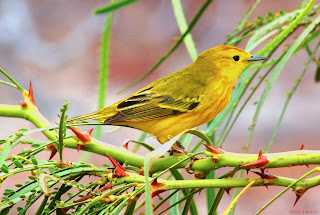 |
| Yellow Warbler |
This article will guide you through the most significant visitor sites accessible only by boat, usually by cruise ship. With rare exception, these sites are part of the Galapagos National Park system and heavily monitored and regulated for preservation and conservation purposes; human traffic is restricted.
Playa Tortuga Negra – Black Turtle Beach
 |
| Playa Tortuga Negra All Photographs from Galapagos National Park Service Unless Stated |
 |
| Playa Tortuga Negra Aerial View Showing the Extended Beachfront |
The beach gets its name from the color of its "sand". The "sand" - really finely crushed lava - here is black as the result of sedimentation and erosion of volcanic material. Imagine this beautiful vista that awaits you: coal black sand, a sparkling crystal sea with small white caps, and a gorgeous azure blue sky with puffs of white clouds. This is
 |
| Green Tortoise on Black Stone Volcanic Rock Beach Photograph from Creative Commons by Tim Ellis |
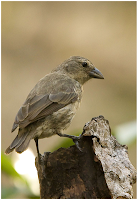 |
| Mangrove Finch Photo WikiCommons |
 |
| Sunset at Black Turtle Beach Photograph from Galapagos National Park Service |
Black Turtle Beach is highly representative of the geological history and diversity of the Galapagos Islands in general and Isabela Island in particular.
Elizabeth Bay
 |
| Galapagos Penguin Photograph Cindy Procter-King |
 |
| Pelican in Red Mangroves Photograph Cindy Proeter-King |
Trips to Elizabeth Bay are restricted by the National Park Service. This inlet on the far western coast of Isabela at the Perry Isthmus is accessible by panga and no landings are allowed. The Bay is located where Volcans Sierra Negra and Alcedo join. This gorgeous marine bay is a wonder to behold. The reason is clear once you are there: this is the situs of the largest concentration of Galapagos Penguins anywhere in the world, along with a significant population of Blue Footed Boobies.
Here is just a taste of what might await you at Elizabeth Bay:
Here is just a taste of what might await you at Elizabeth Bay:
 |
| Penguins Swimming in Elizabeth Bay |
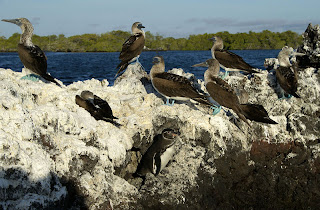 |
| Penguins and Blue Footed Boobies at Elizabeth Bay Photograph from Creative Commons by Mark Putney |
 |
| Panga Approaching Mangrove Swamp Photograph by Cindy Procter-King |
The beauty of this site continues as your panga takes you to an area surrounded by red mangroves. Hopefully, your guide will have the panga engines turned off so that you can listen to the calm that surrounds you. The silence is broken only by the calls of frigate birds, splashes of sea lions and swoosh of brown pelicans as they dive for food. From the panga you should be able to look into the water below and experience sea turtles, spotted eagle rays, golden rays and even flightless cormorants. Cindy Procter-King wrote some delightful blog posts about her experiences at Elizabeth Bay and you can read more here.
Punta Moreno
 |
| Punta Moreno Showing Pahohoe Lava Formations, Flamingo, Cacti and Mangroves Photographs from Galapagos National Park Service |
 |
| Punta Moreno Pahohoe Lava Formation |
 |
| Walking on Lava at Punta Moreno Photograph by Cindy Procter-King |
 |
| Species of Cacti Found on Punta Moreno Photograph by AquaSurround |
 |
| Marine Birds at Punta Moreno |
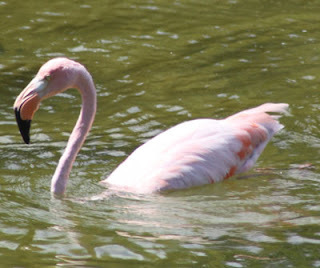 |
| Flamingo in a Tidal Pool |
Punta Albemarle
 |
| Punta Albemarle Panorama Photograph from Creative Commons by Philip Marsh |
 |
| Brown Pelican at Albemarle Photo Creative Commons by mrccos |
 |
| Galapagos Hawk at Albemarle Photograph Creative Commons by mrccos |
Below are additional examples of some of the bird and marine life represented at Punta Albemarle. These photographs are all by Philip Marsh, courtesy of Creative Commons. At Albemarle there are many large marine iguanas – the largest in the entire Galapagos system. Other species at Punta Albemarle include flightless cormorants, multiple types of sea birds and ever-present sea lions.
Urbina Bay
 |
| The Beach at Urbina Bay |
 |
| Coral on Uplifted Area Photo University of Maryland |
 |
| Massive Coral Uplift Photograph University of Maryland |
 |
| Turtle Nests Urbina Bay |
 |
| Iguana and Burrow at Urbina Bay |
 |
| Turtle in Wild at Urbina Bay Photograph by Cindy Procter-King |
This area is also a great place for snorkeling. Green sea turtles, rays and even spiny lobsters frequent these waters.
Roca Rodando
 |
| Roca Rodando at Dusk Photograph from Creative Commons by Arkitina |
This photograph depicts the dramatic, almost surrealistic, view as you near Roca Rodando: a barren monolithic structure emerging from the sea about 30 kilometers from the northwest tip of Isla Isabela. Because it is out of the way, not many travelers have the opportunity to visit Roca Redonda (Round or Rolling Rock), but those who do experience some of nature's true glory. And with that, generally comes a bit of introspection and calm. Roca Rodando can be said to be in the middle of no where and its gravity and presence are surprising. This solitary monumental rock, with extremely steep cliffs and a flat top, rises nearly 1000 feet above the sea. The top of a shield volcano, Roca Redonda has a huge underwater circumference of 18 kilometers (46 miles).
Though viewed only from a boat, and inaccessible except for divers and some strong snorkelers, it still is a stunningly visual and memorable sight. You may be lucky enough to see Roca Redonda as you travel around the top of Isabela Island or on your way to Wolf or Darwin Island.
 |
| In this photo the mother is protecting a chick between her feet. |
The water temperatures are very low here, because of the cold Cromwell current. Diving can be difficult because of the strong currents, unpredictable downcurrents, eddies and the heavy surge. Divers are apt to see sea lions, schools of scalloped hammerheads, yellow tailed surgeonfishes, barracudas, jacks, Galapagos grunts, king angelfishes, Galapagos and white tipped sharks, mantas, and even sunfish. With luck you can also find sea horses. A special attraction is on the Southeast Side of the island. There are several underwater steam vents and gas bubbles rising to the surface, evidence that the volcano is still active.
Caleta Tagus - Tagus Cove
 |
| Rock Face at Tagus Cove |
The trail at Tagus Cove leads to Darwin Lake and Darwin Volcano, both of which are discussed in Part III of the Isabela Visitor Sites posting.
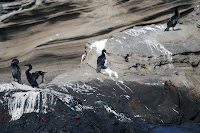 |
| Flightless Cormorants at Tagus Cove Photograph from Wiki |
Another frequently seen bird is the comical and delightful Blue Footed Boobie. No matter what, your visit to Tagus Cove and its surroundings will be memorable, but maybe you will be lucky enough to see Blue Footed Boobies diving into the water as in the following video, by Galaticatt, which I found on Youtube.
Vicente Roca Point
 |
| Vicente Roca Point Photograph by Pablo Castillo |
 |
| Brown Noddy Bird at Vicente Roca Point Photographs from Creative Commons by Mark Putney |
 |
| Fur Seal at Vicente Roca Point Photograph from Creative Commons by Mark Putney |
This bay is great for diving and snorkeling.
 |
| Sea Turtle at Vicente Roca Point Photograph from Creative Commons by bbum |
Seahorses, sea turtles, and the strange yet fascinating Mola-mola (sunfish) may be spotted here. Even fur seals bask on the sundrenched rocks at Vicente Roca Point.
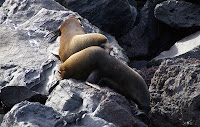 |
| Fur Seal at Vicente Roca Point Photograph from Creative Commons by Mark Putney |




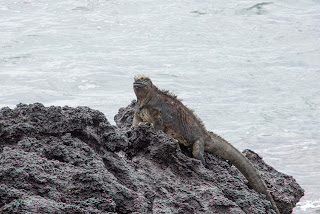






I hope to return to Paradise some day. �� best summer!
ReplyDeleteNice post. I learn something totally new and challenging on sites
ReplyDeleteI stumbleupon on a daily basis. It will always be interesting
to read through articles from other authors and use something from their sites.
Thanks and I have a neat give: How Much House Renovation Cost Philippines home renovation designers near me
ReplyDelete